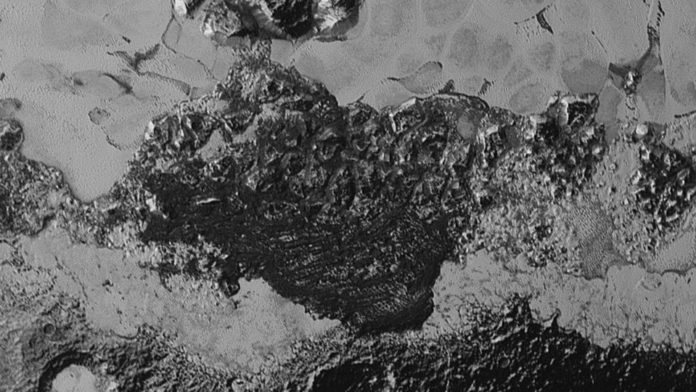Scientists have discovered an unexpected landscape on the dwarf planet.
When Jani Radebaugh saw a picture of Pluto a few years ago, she saw something that reminded her of Earth.
She was examining one of the high-resolution images taken by New Horizons, the nasa spacecraft that swung by the dwarf planet in 2015 before coasting deeper into the solar system. In one spot, Pluto’s gray surface resembled the Mesquite Flat Sand Dunes, in California’s Death Valley, where the landscape undulates with silky ripples in the hot sand. Radebaugh, a planetary scientist at Brigham Young University, often takes her students there for field trips.
“I looked at that region [on Pluto] and thought to myself, ‘Wow, those are sand dunes,’” Radebaugh says.
Radebaugh and her friend Matt Telfer, a lecturer in physical geography at the University of Plymouth, decided to take a closer look. Using New Horizons data and computer modeling, the pair and their team found more than 300 ridges and several wind streaks in one of Pluto’s largest features, a plain called Sputnik Planitia. The dunes stretch for nearly 50 miles across the plain, which is nestled among tall mountains. And unlike sand dunes on Earth, Pluto’s dunes are made out of grains of frozen methane.
Dunes form on Pluto in the same way they do on Earth. Winds carry loose grains through the atmosphere and shape them into gently sloping peaks.
Scientists have observed dunes on other bodies in the solar system, including Mars, Venus, Saturn’s moon Titan, and even a comet called 67P/Churyumov-Gerasimenko. The planets and moon all have atmospheres that can sustain grain-sweeping winds, and the comet ejects jets of gas that, when they hit the surface at the right angle, can stir up particles and send them flying. “As long as we have something that can move particles or sand grains, then we should also have dunes,” Radebaugh says.
But scientists hadn’t expected to find them on Pluto. The dwarf planet does have an atmosphere, but it’s so thin that they didn’t think the wind there would be powerful enough to sweep the landscape into peaks and valleys. “The wind is sufficient to move the particles away, but it’s not sufficient to lift up the particles,” says Cathy Olkin, a planetary scientist at the Southwest Research Institute and a deputy project scientist for New Horizons.
To shape dunes on Pluto, the wind needs a little help from a process called sublimation. In the afternoons, when Pluto is at its warmest, sunlight gently heats up the upper layers of the surface and sends large amounts of icy particles flying into the atmosphere, sometimes at high speed. There, the wind takes them away, scattering them across the plain. “It’s moving fast enough that if there’s a grain that’s already lofted, it would be able to keep carrying that grain and then deposit it into dunes,” Radebaugh says. “And that moving grain could hit another grain, and it could start a chain reaction downwind.”
Over time, these processes work in tandem to create windswept ripples. The researchers say the dunes appear relatively undisturbed, which suggests they formed recently in Pluto’s geological history.
The researchers initially thought the dunes were made of grains of frozen nitrogen, which makes up most of the surface of Sputnik Planitia. But they found that frozen nitrogen particles, at the temperatures that exist in this region, are quite soft and clump together. To make dunes, you need coarse, loose grains that can be easily scattered across distances.
Further analysis of the New Horizons data revealed high concentrations of methane on the mountaintops that surround the plain. “Those particles could get lofted off the mountain peaks and then blown downhill and across the glacier surface, and deposited in dunes,” Radebaugh says.
The discovery is thrilling for Pluto researchers.
“Pluto is so far away from the sun that we really thought it’d maybe be a cold, frozen world,” Olkin says. “But when we got there and took these images with New Horizons, we saw that it’s actually an active world.”
So, what would it be like if you could stand on the surface of Pluto, in the middle of a field of methane dunes? It would be windy, but you wouldn’t feel the force of it. On planets where the atmosphere is thin, 100-mile-an-hour-winds feel like gentle breezes, Radebaugh says.
The methane grains, if you could hold them in your hand, would feel like grains of terrestrial sand, fine and fairly uniform in size. “You’d hold your hand sideways and it would all fly off just like regular sand does,” Radebaugh says.
And the view would be mesmerizing: silky dunes for miles and miles, with snow-capped mountains stretching into the sky behind them. But on Pluto, Radebaugh says, “they’d be capped with snows of methane.”



















































